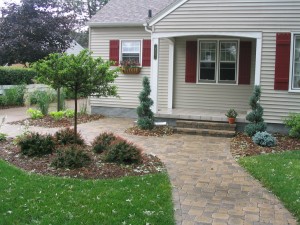Why does anyone live in zone 3b-4? It’s vivid, fluorescent “fiddle heads” in spring popping up with wet moss underfoot. Mystifying northern lights that enrapture the heart dance across the sky on cool summer evenings. Hardwood forests heat up with analogous warm hues that crescendo in the fall. Winter branches heavy with snow create magic tunnels. It is easy to envy zone 5-6, but then the magnificent lady slippers bloom and everything is right.
Wisconsinis a potpourri of farm fields, wooded hills, rocky bluffs, and low wet swamps. The northern part of the state is punctuated with thousands of lakes. The greatMississippihelps border the west while theGreat Lakeshelp enclose the east and north.Wausau, where I reside with my family, is considered the “gate way” to God’s country. It is located in the heart of the dairy land.
For the Landscaping business, time is limited in the north. It’s not for the weak of spirit. Work is fast and efficient, with preparation as the key. Hours are spent in the dark winter months preparing for the spring thaw. Details are worked out ahead of time to alleviate wasted time. Equipment is tuned and people are ready to work hard as the snow melts away.
Hardscaping is one of the most vital aspects of the design process. Without a “backbone”, landscape design falls apart. I define hardscaping as, “Anything not living in the garden.” That would include, but is not limited to: concrete, asphalt, clay, rubber, wood, metal, fabric, glass, lighting, pottery; and, with its indigenous strength the greatest of these is rock.
Incorporating rock solidifies design concepts. The strength of rock also compliments the softness of the snow which blankets our earth so much of the year. We are blessed with an abundance of different types of rock here in Wisconsin. There are quarries of red granite as well as soft sandstones. Thanks to the great glaciers, there are literally fields of granite boulders of all sizes. In addition, many other types of fractured
rock are blasted out of the hills, making way for roads and buildings.
Hardscaping can act as an adhesive by connecting the outdoor gardens with the main residence, or place of business. It acts as an integrating agent by repeating, coordinating, or contrasting the building materials already used on the site. This brings harmony to the surroundings. Native rock working in harmony with other handscaping materials, as well as plant materials, is the cohesive element in our landscape designs.
Hardscaping should have longevity and offer a sense of permanence. It should be designed, placed and constructed with this in mind. Hardscaping elements are visible during all seasons. They must hold the garden together with interest even when the plants are resting or covered with snow. If plant materials are the “yin” in the garden, hardscaping is the “yang.” Hardscape allows the plant materials to sing with softness, color, texture and fragrance. Like any good relationship there must be balance between the two elements to achieve the highest possible end result.
Hardscaping is many things, but most of all, functional. It holds, retains, paves, encloses, transitions, accents, and beautifies. Hardscaping a garden properly can add safety features such as railings or lighting. Hardscaping adds places of rest and reflection by incorporating benches and water. A garden can add areas of play and activity with properly designed sports courts, pools and play grounds.
Like any good piece of music, the gardens have to sing, building with “fortes” and softening with “pianos.” Hardscaping can help achieve this by bringing “cause for pause” in the form of a small bench area set inside the garden. Hardscaping also helps add impact by using compression and release. An example of this might be a gateway at the end or beginning of a path, marking the opening to a large grassy lawn. In these ways it intervenes and helps control the participant’s attention, subtly adding a sense of safety, rest, harmony, and direction. Hardscaping may give direction and visual movement in the form of destinations and focal points, drawing the participant out into the environment, and helping to entice the senses.
In the future when planning a landscape or garden setting, I hope you will give more thought to hardscaping and the importance of using it properly. Its dependability is very attractive in this ever changing world.
 SPRING—(BEGINNING OF APRIL TO MID JUNE)
SPRING—(BEGINNING OF APRIL TO MID JUNE)
